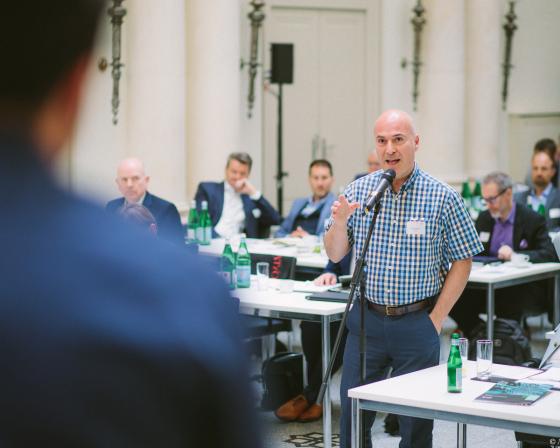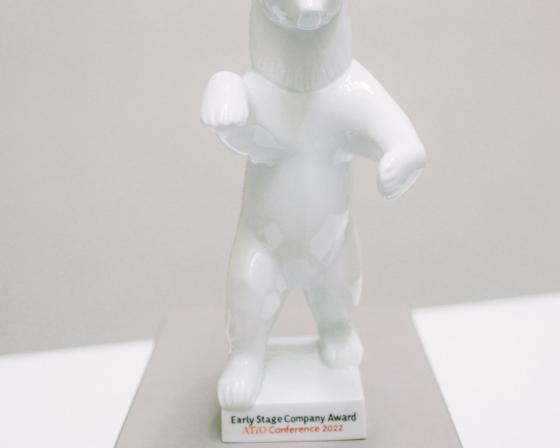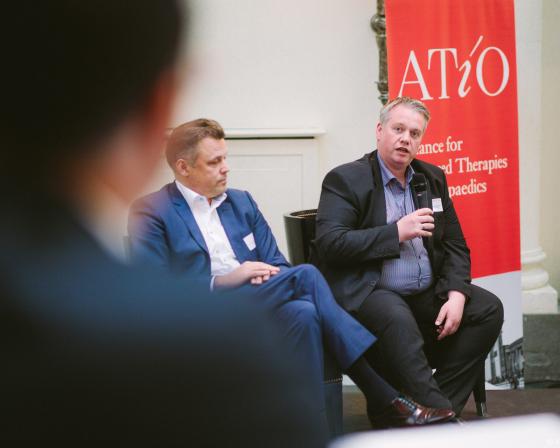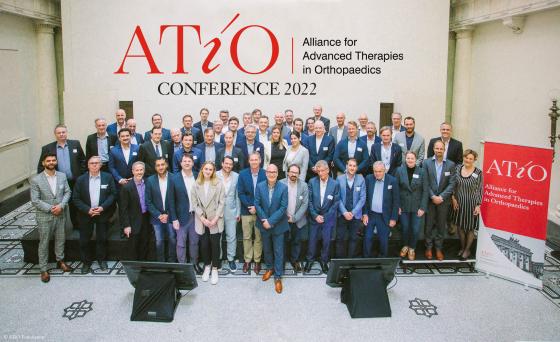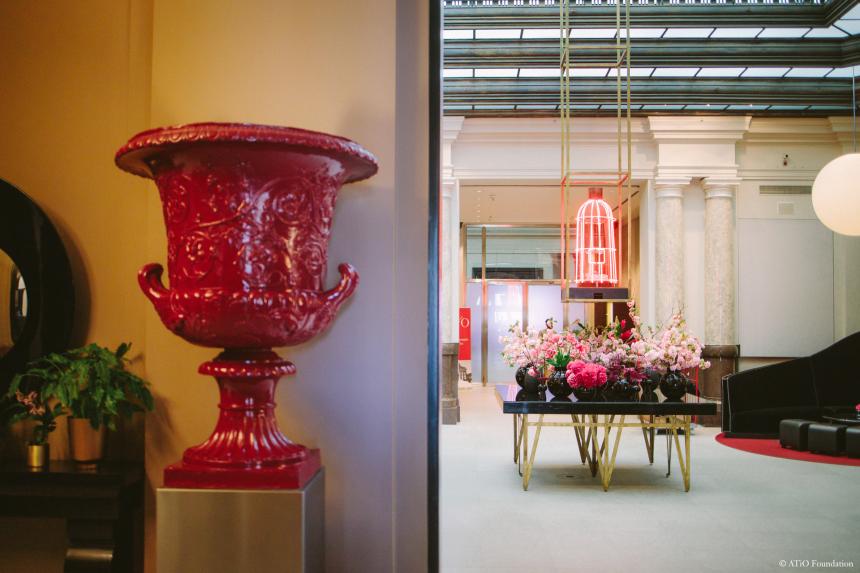ATiO Conference 2022: Summary
The 1st ATiO Conference, hosted at the Hotel de Rome in Berlin, has come to an end and set the beginning of a fruitful joint endeavour to accelerate the progress in the field of advanced therapies in orthopaedics.
An event full of input and discourses on different perspectives of advanced therapies in orthopaedics - sparking a new way of thinking and providing the path for future collaboration.
We want to present a small recap of what happened throughout the ATiO Conference 2022.
After the welcoming address and presenting the purpose and vision of the ATiO Foundation, we kicked off the event with an inspiring keynote lecture by Scott Bruder about navigating the risks and opportunities in regenerative orthopaedic medicine products development. We were given an overview of the current market of advanced therapies in orthopaedics and were walked through some pitfalls and step-by-step guides while enjoying drinks and finger food in the beautiful opera court of the Hotel de Rome. With plenty of questions to be asked and ideas to share the evening ended in an open end.
Saturday morning started with two separate blocks of the “Research vs Reaction” format where key opinion leaders (KOLs) from the free-market economy and research react to the latest innovations and concepts presented by each other.
The first block was all about “Gels and Scaffolds”, moderated by Andrew Williamson and Tobias Winkler, including:
-
“A though hydrogel – a revolution in tendon healing?” by Eckhard Weber, Project Team Head at Novartis AG, with a Reaction Talk by Joost de Bruijn, CEO at Kuros Biosciences AG
-
“Scaffolds of the future – a matter of architecture?” by Ansgar Petersen, Principal Investigator - Cellular BioMechanics & BioMaterials at BIH: Berlin Institute of Health, with a reaction by Beat Lechmann, Director of R&D Innovation, Trauma at DePuy Synthes
-
“Mechanical actuation trough Janus scaffolds: Do stem cells like classic or rock music to make bone?” by Lorenzo Moroni, Principal Investigator in Biofabrication at MERLN – Maastricht University, with a reaction by Peter Dines, COO at Mercia Asset Management PLC
-
“How can biomaterials better harness regenerative mechanisms?” by Kevin Shakesheff, Professor of Tissue Engineering at Nottingham University, and a reaction by Andrew Evans, International Commercial Executive at DSM Biomedical
-
“Silkfibrion-compounds as a scaffold for osteochondral tissue engineering” by Stefan Nehrer, Dean - Faculty of Health & Medicine at Danube University Krems, and a reaction by Michael Diefenbeck, CMO at BoneSupport AB
The second block focused on “Cell Therapies”, moderated by Georg Duda & Stuart Goodman:
-
“Cell therapy for spinal disc regeneration” by Dmitriy Sheyn, Assistant Professor for Orthopaedics & Surgery at Cedars-Sinai Medical Center, with a reaction by Zami Aberman, CEO at Pluristem Therapeutics Inc.
-
“Placenta cells for muscle regeneration” by Tobias Winkler, Senior Physician & Head of the Regenerative Orthopedics and Trauma Surgery Section at Charité -Universitätsmedizin Berlin & BIH: Berlin Institue of Health, with a reaction by Andrew Williamson, CEO at Heraeus Medical GmbH
-
“If you want bone – you need cartilage” by Dirk Strunk, Director of Institute for Experimental and Clinical Cell Therapy at PMU Salzburg, with a reaction by Tilmann Bur, CEO at CO.DON AG
-
“Genetically modified cell therapies for bone regeneration” by Stuart Goodman, Robert L. and Mary Ellenburg Professor of Surgery, and Professor with Tenure in the Department of Orthopaedic Surgery at Stanford University, with a reaction by Detlef Schumann, CEO at TETEC AG
-
“Advancing osteoarthritis gene therapy into the clinic” by Christopher H. Evans (Professor of Orthopaedics and Physical Medicine & Rehabilitation at Mayo Clinic, and a reaction by Devin Childers, CEO at Heraeus Medical USA
The format created a vivid exchange between the field of science and finance which built a good foundation for the following World Café with the hosts Scott Bruder, Manuel Groth, Georg Duda, Jan Engels & Carsten Perka. After 3 rounds à 15 minutes of knowledge exchange and creative work, the results of each group were presented by the host on the stage.
The following topics were discussed:
-
“Criteria for early-stage investment” by Scott Bruder, Founder and CEO, Physician-Scientist Executive, Board Member at Bruder Consulting Venture Group & Brown University Franklin Lakes
-
“Criteria for industry involvement” by Manuel Groth, Head of Business Development at Heraeus Medical GmbH
-
“Working with universities – which model?” by Georg Duda, Director at BIH: Berlin Institute of Health, Julius Wolff Institute (JWI)
-
“Success criteria for start-up development in advanced therapies” by Jan Engels, Investment Manager at High-Tech Gründerfonds (HTGF)
-
“Which innovations do we need in ortho and trauma?” by Carsten Perka, Medical Director of Center for Musculoskeletal Surgery at Charité - Universitätsmedizin Berlin
In the afternoon the first-ever Early Stage Corporate Presentation Award was granted to mimiX Biotechnologies Ltd., represented by CEO Marc Thurner, based on an online community voting. Their innovative approach to medical 3D printing by creating different patterns of vertical vibration via sound convinced the majority of the crowd and made them stand out among the other participants including Locate Bio, MICA Biosystems, In Silico Trials, Novadip Biosciences – each presenting amazing new innovative approaches to the field.
After a short break, world-renown structures for advancing regenerative orthopaedics were presented. With the moderation of Philippe Halbout and Enrique Gomez Barrena we received input on the Institute for Technology-Inspired Regenerative Medicine (MERLN) by Lorenzo Moroni, Berlin Institute of Health (BIH) by Christan Baum, Berlin Center for Advanced Therapies (BeCAT) by Dimitrios Laurin Wagner and the Osteoarthritis Research Society International (OARSI) by Ali Mobasheri.
The licensing talks by Ashurst partners Stephan Hennrich and Fabian Klein gave good insights about the “dos & don’ts” concerning patents, trademarks, copyrights, trade secrets, and IP in general, while Christian A. Stein made an emphasis on the value of early medical technology inventions in his presentation.
As a follow-up, two regulatory panels were held and moderated by Ali Mobasheri and Mohamed Abou-El-Enein including two ignition talks: Philipp Halbout presented the IOF/ESCEO approach to patient involvement and Dieter Wiek evaluated the corresponding approach of the EULAR. The foundation was set for the following panel on “How to involve patient interests in advanced product development” in which Mohit Chhaya, Sven Geißler, Philipp Halbout, and Dieter Wiek participated.
The 5 big regulatory questions in international ATMP development were evaluated by Mohamed Abou-El-Enein to set the stage for the regulatory panel presented by Robin Büscher, Pieter Means, Benjamin Hagedorn, Yaroslav Issakov.
We ended the sunny Saturday with a sightseeing boat trip through the watersides of Berlin enjoying a good variety of German & Austrian cuisine and drinks by CULINARIUM – with a local guide we also got insights into the history of berlins architecture, districts, past and presence in general.
Sunday morning, the day started with an introduction to the ORTHOUnion – A European Cell Therapy Approach. Enrique Gomez Barrena presented the ORTHOUnion trial in general, Pierre Layrolle walked us through bone regeneration strategies using biomaterials and stem cells, Ilenia Mastrolia followed up with predicting osteogenic function and signature in autologous mesenchymal stem cell (MSC) and Hubert Schrezenmeier gave us an overview of current approaches and new strategies for MSC expansion.
Following, Katharina Schmidt-Bleek and Dietmar W. Hutmacher held two stunning keynote lectures.
Katharina Schmidt-Bleek kept us hooked with a beautiful presentation about the role of the immune system in bone healing showing new super interesting approaches to the topic, while Dietmar W. Hutmacher gave us an insight into his 21st-century approach to individualized scaffold technology.
The event was rounded off by a panel on “What will the future bring?” with Michael Diefenbeck, Chris Evans, Beat Lechmann, Katja Schenke-Layland, Dmitriy Sheyn, and Herbert Stadler. Michael Bröker asked two fundamental questions: “What is the most promising disruption technology that will be translated into clinical application in the next 10 years?” and “What is the main blocking barrier to be expected?”
After speaking about the importance of osteoarthritis treatments, different scaffold coating possibilities, and the fundamental difference between fundraising in Europe and America – the event came close to its final and was finished with a wrap-up & take-home message by Tobias Winkler & Michael Bröker.
We want to thank everybody who took part in the ATiO Conference and the organization of the programme and event as such. We especially want to thank all members of the Scientific Board, the Advisory Board and the organisation team of the ATiO, who deliberately worked on making this event come alive.
Thanks to all sponsors, especially Heraeus Medical and BONESUPPORT AB as well as Kuros Biosciences, CO.DON AG, Pluristem Therapeutics, BellaSeno, Locate Bio Ltd, Enovis & Ashurst, who made this event possible.








